PEEK Performance Center
Dynamic Stiffness as a Measure of PEEK Playability
By Steve Crandall
Vice President, Sales & Marketing
Ashaway Racket Strings
In our last article, we said that in racquet strings, "PEEK offers low dynamic stiffness that allows it to deform and recover more completely than other synthetic materials." And also that it can also be made "to have exceptionally low creep under continuous tension, allowing racquet strings to maintain tension and playability longer." Maintaining tension and playing longer are easy to understand, but several readers were unfamiliar with the concept of dynamic stiffness and asked that we explain it more fully.
In a word, dynamic stiffness equates to elasticity or resilience: i.e., the ability of an object or material to resume its normal shape after being stretched or compressed. But while elasticity and resilience are general expressions, dynamic stiffness is an engineering term that can be quantified. As it applies to string, it is measured in pounds per inch, and is a measure of how much a string stretches when it strikes the ball before rebounding to its original shape. The more stretch, the more power it returns to the ball and the less impact it has on your arm and elbow. Conversely, the less a string stretches, the more energy is lost in flattening the ball and the less total power is available for rebound.
To see how this plays out, let's take a look at the original 'gold standard' for string, natural gut. Gut has a number of properties that make it ideal for racquet strings. Made from the intestines of cows, its performance has been unmatched since it was first introduced in the nineteenth century. What makes gut a superstar is its ability to stretch on impact and then rebound quickly without deformation or loss of tension: i.e., its dynamic stiffness. This allows it to do several things: 1) gut absorbs the force of impact, not the racquet or the player's arm. In other words, gut plays "soft;" 2) it returns that force to the ball very quickly and efficiently, providing more power; 3) because it stretches, it allows the ball more dwell time on the strings. This lets you "pocket" the ball and enhances control; 4) gut maintains tension over the life of the string, enhancing its value. Gut is also quite durable when struck on the sweet spot, but not so much on off-hits, making it better for better players. On the downside, gut is very expensive and, without protective coatings, is very sensitive to moisture-it swells up and sags.
Thus, the key to gut-like playability is dynamic stiffness. It is expressed as a number (lbs./in) and the lower the dynamic stiffness 'score', the better. For today's leading natural gut string, this number comes in around 102, according to the US Racquet Stringers Association (USRSA).
For years now manufacturers have been trying to find a synthetic string material whose properties match the dynamic stiffness of natural gut. Some of the most popular materials today are polyester and co-polyester polymers. Most polyester and co-polyester strings are solid monofilaments: a single filament extrusion with varied profiles and surface textures. These strings are not sensitive to moisture and do provide good abrasion resistance. But in terms of dynamic stiffness, polyester and co-polymer strings range between 226 and 242 lb./in. This is not bad compared with ultra-stiff aramid strings, but it's still quite stiff. In fact, high-end polyester and co-polymer monofilament strings have been called 'gut on steroids' and are designed for hard-hitting, high-end professional players. And their prices reflect that.
The chart below shows comparative data of several strings, including the best-selling Natural Gut. I have to qualify this chart by saying that, except for the Dynamic Stiffness numbers which were provided by USRSA, all the other tests were done in Ashaway's own lab, which is not an independent certified lab. Nevertheless, the numbers should be close enough to give you a clearer picture of how dynamic stiffness works.
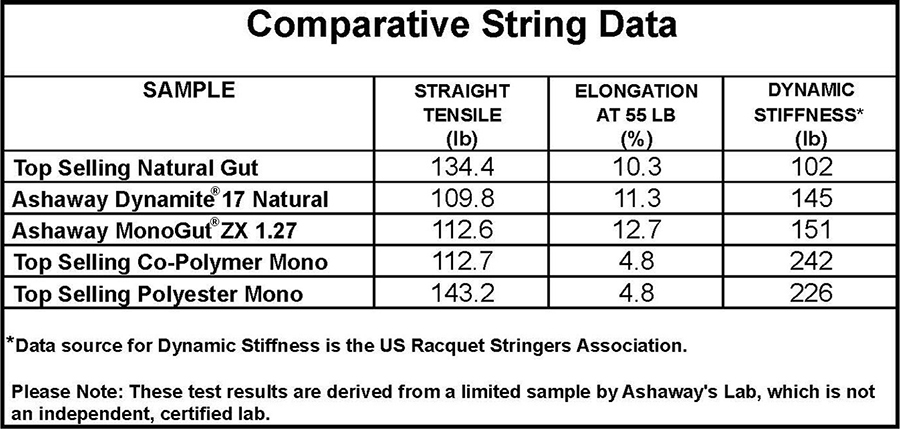
The first column shows the tensile strength of the various strings, which is the force required to stretch the string close to its breaking point. Note that the leading polyester mono has higher tensile strength than gut while all the others have less. So it's stronger, and one would think, provides more power. But not so. Look at the next column, "Elongation at 55 lb.," which is the amount a string stretches at racquet tension, expressed as a percentage of length. Polyester and co-polymer strings stretch less than half as much as gut, while both ZX (PEEK) strings stretch more. This means that polyesters are much stiffer and return less power to the ball.
By comparison, the dynamic stiffness of PEEK is the closest to gut of any synthetic string material. That's why we call it a "man-made polymer equivalent to natural gut." This means it absorbs and returns impact force more like gut. It controls the ball more like gut, especially in thinner gauge strings, and holds tension as well, or perhaps even a bit better than gut. PEEK is impervious to moisture and offers excellent abrasion resistance to enhance durability. And, of course, it's cheaper than either gut or the high-end polyesters.
Better still, PEEK offers more variety. Unlike polyesters and co-polymers, which are primarily monofilament constructions, PEEK can be constructed as a multifilament (Ashaway Dynamite® 17 Natural or Dynamite 18 Soft); as a multi-stranded monofilament (Ashaway Dynamite 16 Tough); or, as a straight monofilament in our MonoGut® ZX and MonoGut ZX Pro. This, along with a broader range of gauges than either polyesters or gut, allows players to more closely tailor their string choice to their style of play. We think that's a good story.
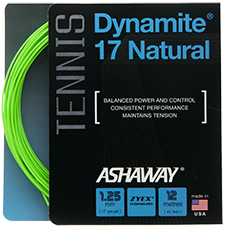
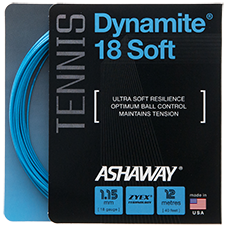
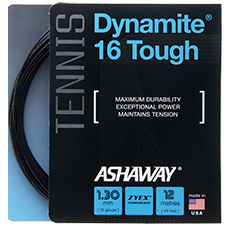
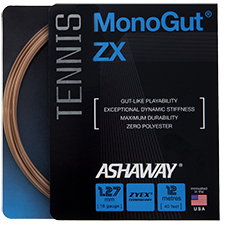
Unlike polyesters and co-polymers, which are primarily monofilament constructions, PEEK can be constructed as a multifilament (Ashaway Dynamite® 17 Natural or Dynamite 18 Soft); as a multi-stranded monofilament (Ashaway Dynamite 16 Tough); or, as a straight monofilament in our MonoGut® ZX and MonoGut ZX Pro. This, along with a broader range of gauges than either polyesters or gut, allows players to more closely tailor their string choice to their style of play.
By Steve Crandall
Vice President, Sales & Marketing
Ashaway Racket Strings
In our last article, we said that in racquet strings, "PEEK offers low dynamic stiffness that allows it to deform and recover more completely than other synthetic materials." And also that it can also be made "to have exceptionally low creep under continuous tension, allowing racquet strings to maintain tension and playability longer." Maintaining tension and playing longer are easy to understand, but several readers were unfamiliar with the concept of dynamic stiffness and asked that we explain it more fully.
In a word, dynamic stiffness equates to elasticity or resilience: i.e., the ability of an object or material to resume its normal shape after being stretched or compressed. But while elasticity and resilience are general expressions, dynamic stiffness is an engineering term that can be quantified. As it applies to string, it is measured in pounds per inch, and is a measure of how much a string stretches when it strikes the ball before rebounding to its original shape. The more stretch, the more power it returns to the ball and the less impact it has on your arm and elbow. Conversely, the less a string stretches, the more energy is lost in flattening the ball and the less total power is available for rebound.
To see how this plays out, let's take a look at the original 'gold standard' for string, natural gut. Gut has a number of properties that make it ideal for racquet strings. Made from the intestines of cows, its performance has been unmatched since it was first introduced in the nineteenth century. What makes gut a superstar is its ability to stretch on impact and then rebound quickly without deformation or loss of tension: i.e., its dynamic stiffness. This allows it to do several things: 1) gut absorbs the force of impact, not the racquet or the player's arm. In other words, gut plays "soft;" 2) it returns that force to the ball very quickly and efficiently, providing more power; 3) because it stretches, it allows the ball more dwell time on the strings. This lets you "pocket" the ball and enhances control; 4) gut maintains tension over the life of the string, enhancing its value. Gut is also quite durable when struck on the sweet spot, but not so much on off-hits, making it better for better players. On the downside, gut is very expensive and, without protective coatings, is very sensitive to moisture-it swells up and sags.
Thus, the key to gut-like playability is dynamic stiffness. It is expressed as a number (lbs./in) and the lower the dynamic stiffness 'score', the better. For today's leading natural gut string, this number comes in around 102, according to the US Racquet Stringers Association (USRSA).
For years now manufacturers have been trying to find a synthetic string material whose properties match the dynamic stiffness of natural gut. Some of the most popular materials today are polyester and co-polyester polymers. Most polyester and co-polyester strings are solid monofilaments: a single filament extrusion with varied profiles and surface textures. These strings are not sensitive to moisture and do provide good abrasion resistance. But in terms of dynamic stiffness, polyester and co-polymer strings range between 226 and 242 lb./in. This is not bad compared with ultra-stiff aramid strings, but it's still quite stiff. In fact, high-end polyester and co-polymer monofilament strings have been called 'gut on steroids' and are designed for hard-hitting, high-end professional players. And their prices reflect that.
The chart below shows comparative data of several strings, including the best-selling Natural Gut. I have to qualify this chart by saying that, except for the Dynamic Stiffness numbers which were provided by USRSA, all the other tests were done in Ashaway's own lab, which is not an independent certified lab. Nevertheless, the numbers should be close enough to give you a clearer picture of how dynamic stiffness works.

The first column shows the tensile strength of the various strings, which is the force required to stretch the string close to its breaking point. Note that the leading polyester mono has higher tensile strength than gut while all the others have less. So it's stronger, and one would think, provides more power. But not so. Look at the next column, "Elongation at 55 lb.," which is the amount a string stretches at racquet tension, expressed as a percentage of length. Polyester and co-polymer strings stretch less than half as much as gut, while both ZX (PEEK) strings stretch more. This means that polyesters are much stiffer and return less power to the ball.
By comparison, the dynamic stiffness of PEEK is the closest to gut of any synthetic string material. That's why we call it a "man-made polymer equivalent to natural gut." This means it absorbs and returns impact force more like gut. It controls the ball more like gut, especially in thinner gauge strings, and holds tension as well, or perhaps even a bit better than gut. PEEK is impervious to moisture and offers excellent abrasion resistance to enhance durability. And, of course, it's cheaper than either gut or the high-end polyesters.
Better still, PEEK offers more variety. Unlike polyesters and co-polymers, which are primarily monofilament constructions, PEEK can be constructed as a multifilament (Ashaway Dynamite® 17 Natural or Dynamite 18 Soft); as a multi-stranded monofilament (Ashaway Dynamite 16 Tough); or, as a straight monofilament in our MonoGut® ZX and MonoGut ZX Pro. This, along with a broader range of gauges than either polyesters or gut, allows players to more closely tailor their string choice to their style of play. We think that's a good story.




Unlike polyesters and co-polymers, which are primarily monofilament constructions, PEEK can be constructed as a multifilament (Ashaway Dynamite® 17 Natural or Dynamite 18 Soft); as a multi-stranded monofilament (Ashaway Dynamite 16 Tough); or, as a straight monofilament in our MonoGut® ZX and MonoGut ZX Pro. This, along with a broader range of gauges than either polyesters or gut, allows players to more closely tailor their string choice to their style of play.
ZYEX® is a registered trademark of Victrex Ltd.
Ashaway Line & Twine Mfg. Co.
24 Laurel Street
Ashaway RI 02804
Telephone:
(800) 556-7260 (from within USA)
or (401) 377-2221
Copyright © 2025 Ashaway Line & Twine Mfg. Co. | All Rights Reserved


